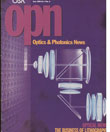
June 1998 Issue
- Optical MEMS: Huge Possibilities for Lilliputian-Sized Devices
- The Business Behind Optical Lithography
- Software for Optical Design: Has It Changed the Role of the Lens Designer?
- A Web-users Guide to Photonics in Australia
- Scanning Optical Microscopy: Part 2
- The Temporal Talbot Effect
- Diffraction-limited Endoscope System
- Door Peepers
- Browse all Issues
Feature Articles
Optical MEMS: Huge Possibilities for Lilliputian-Sized Devices
Recent advances in micro-electro-mechanical systems (MEMS) have made it possible to produce entire micro-optical systems in a single chip. After describing this exciting technology, micro-optical benches, XYZ stages, and fiber optic switches are explored.
by Ming C. Wu, Li Fan, and Shi-Sheng LeeThe Business Behind Optical Lithography
Reiss examines the players and the forces that are driving the availability of materials and light sources for the optical lithography market.
by Susan M. ReissSoftware for Optical Design: Has It Changed the Role of the Lens Designer?
Optical design software has become more powerful, easier to use, and less expensive than ever before. After describing the basic components of a traditional lens design program, the authors explore other tools that help to create better optical products.
by Peter P. Clark and Jane BareauA Web-users Guide to Photonics in Australia
Many optic and photonic companies, research and educational institutions, and societies now have Web sites that provide useful information to users. The majority of these sites belong to North American, European, and Japanese organizations. Australia has a small economy by comparison, but has recently seen emerging activity in photonics. This column reviews some of the current photonic activities in Australia, referencing those with Web sites, so interested readers can contact them.
by Graeme PendockScanning Optical Microscopy: Part 2
Last month we began a discussion of diffraction-limited focusing of a laser beam for the purpose of scanning a surface. We discussed the size of the focused spot and the corresponding depth of focus under various circumstances. This month's column continues the discussion, concentrating on focusing through solid immersion lenses.
by Masud Mansuripur, Lifeng Li, Wei-Hung YehThe Temporal Talbot Effect
There is a well-known analogy between spatial and temporal effects in optics. Self focussing is the spatial analogue to self phase-modulation: both are due to the Kerr non-linearity, but one acts in the plane transverse to the direction of propagation, the other in the longitudinal direction, or temporal domain. Similarly, group velocity dispersion is the temporal analogue of diffraction in space. It is therefore, perhaps, not so surprising that the analogy applies to a very peculiar case of diffraction.
by F. Mitschke and U. MorgnerDiffraction-limited Endoscope System
Acommon approach in designing an objective-relay system is to design the objective and relay subsystems separately and then simply put them together without further optimization. Although this approach is straightforward, it requires that each subsystem be well corrected, particularly for field curvature and astigmatism. In the case of an endoscope system, which consists of an objective and several sets of relay lenses, it is particularly important that the individual relay sub-units have a very flat anastigmatic field. This is because the field curvature of the complete relay system is equal to that of a single sub-unit multiplied by the number of units, typically four or five.
by J. Brian CaldwellDoor Peepers
The ordinary security door peeper, or door viewer, has a number of uses—pedagogical, practical, and fun. This article presents a range of demonstrations using door peepers. For many of these demonstrations, the essential feature of the door peeper is that it compresses an entire hemisphere of phenomena into an angle small enough to fit the retina, so things that vary over a wide range of angles can be comprehended in a single view.
by Douglas S. Goodman

![A multiplexed image of a human tonsil acquired. [NIAID] using the iterative bleaching extends multiplexity (IBEX) method.](https://opnmedia.blob.core.windows.net/$web/opn/media/images/articles/2024/0424/departments/202404-cover-web.jpg?ext=.jpg)
